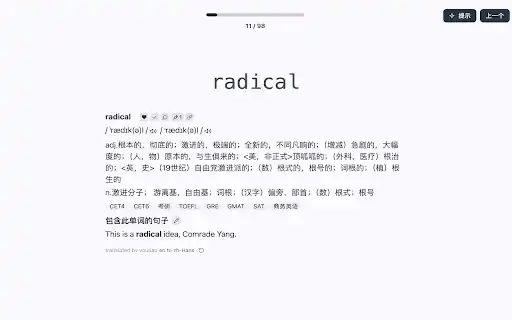https://chromewebstore.google.com
LingoBuddy: Your Friendly Language Learning Partner
LingoBuddy is more than just a language learning app; it’s your personal language tutor. Designed to make language learning fun and effective, LingoBuddy combines AI-powered technology with engaging lessons and interactive exercises. Whether you’re a beginner or looking to perfect your fluency, LingoBuddy is your key to unlocking the world of languages.
Sure, I can provide some general pros and cons for various topics or specific items. Could you please specify what you’d like the pros and cons for? For example, a particular tool, technology, method, or concept?
Are you looking for the pros and cons of different pricing strategies (e.g., cost-plus pricing, dynamic pricing, subscription-based pricing), or do you need information on the pricing of a specific product or service? Please provide more details so I can give you a more accurate and useful response.
Sure, here are some pros and cons of various pricing strategies:
1. Cost-Plus Pricing
Pros:
- Simplicity: Easy to calculate and implement.
- Predictable Profit Margins: Ensures a consistent profit margin as it adds a fixed percentage over the cost.
- Transparency: Customers can understand the pricing rationale.
Cons:
- Ignores Market Demand: Doesn’t consider what customers are willing to pay.
- Potentially Uncompetitive: May result in prices that are higher or lower than competitors.
- Inefficient Cost Control: Encourages less focus on controlling costs since they are simply passed on to the customer.
2. Value-Based Pricing
Pros:
- Customer Focused: Prices are set based on perceived value to the customer.
- Higher Profit Margins: Can potentially charge higher prices if the perceived value is high.
- Competitive Advantage: Can differentiate products based on value rather than price alone.
Cons:
- Complexity: Requires deep understanding of customer perceptions and value.
- Market Research: Needs extensive market research and data analysis.
- Risk of Misjudgment: Misjudging value can lead to setting prices too high or too low.
3. Dynamic Pricing
Pros:
- Maximizes Revenue: Adjusts prices based on real-time supply and demand, maximizing revenue.
- Flexibility: Can quickly respond to market changes.
- Inventory Management: Helps manage inventory by adjusting prices to influence demand.
Cons:
- Customer Dissatisfaction: Customers may feel treated unfairly if they notice frequent price changes.
- Complex Implementation: Requires sophisticated technology and algorithms.
- Price Wars: Can lead to price wars with competitors if not managed carefully.
4. Penetration Pricing
Pros:
- Market Entry: Helps quickly attract customers and gain market share.
- Discourages Competition: Low prices can deter potential competitors from entering the market.
- Customer Base: Builds a large customer base rapidly.
Cons:
- Low Initial Profit: Can result in low or negative profit margins initially.
- Price Expectations: Customers may expect low prices in the long term, making it hard to raise prices later.
- Sustainability: May not be sustainable if costs are not covered.
5. Skimming Pricing
Pros:
- High Initial Profits: Targets customers willing to pay a premium, resulting in high initial profits.
- Perceived Quality: High prices can create an image of quality and exclusivity.
- Recoup Costs: Helps recoup development costs quickly.
Cons:
- Limited Customer Base: Only attracts price-insensitive customers.
- Encourages Competition: High margins can attract competitors.
- Price Adjustments: Requires careful management of price reductions over time.
6. Subscription-Based Pricing
Pros:
- Predictable Revenue: Provides a steady and predictable revenue stream.
- Customer Retention: Encourages long-term customer relationships and loyalty.
- Scalability: Easy to scale as the customer base grows.
Cons:
- Churn Risk: High customer churn can negatively impact revenue.
- Initial Cost: May require significant upfront investment in acquiring subscribers.
- Complex Management: Requires managing subscriptions, renewals, and customer engagement.
If you have a specific context or product in mind, let me know for more tailored insights!
FAQs (Frequently Asked Questions) are a common way to provide quick and accessible answers to common queries about a product, service, or topic. Here are some pros and cons of implementing an FAQ section:
Pros of an FAQ Section
1. Efficiency and Time-Saving:
- Quick Answers: Provides users with immediate answers to common questions, saving them time.
- Reduced Support Load: Reduces the volume of repetitive queries to customer support, allowing the team to focus on more complex issues.
2. Improved User Experience:
- Easy Navigation: Users can quickly find the information they need without having to contact support.
- Self-Service: Empowers users to solve their problems independently.
3. SEO Benefits:
- Increased Visibility: Well-structured FAQs can improve search engine rankings by including relevant keywords.
- Rich Snippets: FAQs can appear in rich snippets on search engines, increasing click-through rates.
4. Trust and Credibility:
- Transparency: Demonstrates a willingness to address common concerns openly.
- Confidence: Helps build trust with potential customers by showing that you understand and can address their needs.
5. Comprehensive Resource:
- Consolidated Information: Centralizes important information in one place, making it easier for users to find what they need.
Cons of an FAQ Section
1. Maintenance:
- Regular Updates: Requires regular updates to ensure the information remains accurate and relevant.
- Resource Intensive: Keeping the FAQ section up-to-date can be time-consuming and resource-intensive.
2. Potential Overwhelm:
- Information Overload: A poorly organized FAQ section with too many questions can overwhelm users.
- Complex Navigation: Users may struggle to find the specific answer they need if the FAQ section is not well-structured.
3. Limited Personalization:
- Generic Answers: FAQs provide general answers that may not fully address specific user queries or issues.
- Lack of Engagement: Can lack the personal touch that live customer support provides.
4. Dependence on User Initiative:
- User Effort Required: Users must take the initiative to search the FAQ section for answers, which some may be unwilling or unable to do.
- Missed Opportunities: May miss opportunities for upselling or providing personalized assistance.
Best Practices for an Effective FAQ Section
- Categorize Questions: Organize questions into clear categories or sections to make navigation easier.
- Prioritize Common Questions: Start with the most frequently asked questions to address the most pressing user needs.
- Use Clear and Concise Language: Write answers in simple, straightforward language to ensure they are easily understood.
- Include a Search Function: Implement a search feature to help users find specific answers quickly.
- Update Regularly: Regularly review and update the FAQ section to keep the information current and relevant.
- Monitor Usage: Track which questions are most viewed or searched to identify new FAQs that need to be added.
An effective FAQ section can greatly enhance user experience and operational efficiency, provided it is well-maintained and user-friendly. If you have a specific product or service in mind, I can tailor the FAQs to better suit that context.
Sure, here are some pros and cons of implementing a conclusion in various contexts, such as in reports, articles, presentations, or essays:
Pros of Including a Conclusion
1. Summarizes Key Points:
- Clarity: Helps readers or listeners remember the main ideas and key points discussed.
- Reinforcement: Reinforces the most important information, ensuring it leaves a lasting impression.
2. Provides Closure:
- Completion: Signals the end of the discussion, providing a sense of closure.
- Resolution: Resolves any open questions or discussions, giving a complete picture.
3. Enhances Understanding:
- Synthesis: Combines different elements of the content to provide a comprehensive understanding.
- Perspective: Offers final thoughts or perspectives that may highlight the significance of the information presented.
4. Encourages Reflection:
- Critical Thinking: Encourages the audience to reflect on the information and its implications.
- Engagement: Engages the audience by prompting them to think about what they have learned or how it applies to them.
5. Call to Action:
- Next Steps: Can include a call to action, encouraging the audience to take specific steps based on the information.
- Motivation: Motivates the audience to apply the knowledge or take further interest in the topic.
Cons of Including a Conclusion
1. Repetition:
- Redundancy: If not well-crafted, conclusions can sometimes feel repetitive, merely restating information without adding value.
- Boredom: Repetitive content may disengage the audience if it doesn’t offer new insights or a fresh perspective.
2. Length and Time:
- Conciseness: Crafting a concise yet comprehensive conclusion can be challenging.
- Time-Consuming: Writing or delivering an effective conclusion takes additional time and effort.
3. Risk of Weak Ending:
- Ineffectiveness: A weak conclusion can undermine the strength of the overall content.
- Negative Impression: If the conclusion fails to effectively summarize or provide insight, it may leave a negative impression.
4. Over-Simplification:
- Complex Topics: In attempting to summarize, complex topics might be oversimplified, potentially misrepresenting the nuances of the discussion.
- Loss of Detail: Important details may be lost in the effort to create a succinct conclusion.
Best Practices for Crafting an Effective Conclusion
- Summarize Key Points: Highlight the most important points discussed, avoiding detailed repetition.
- Synthesize Information: Integrate different elements of the content to present a unified understanding.
- Provide Insight: Offer final thoughts, insights, or perspectives that enhance the overall message.
- Encourage Reflection: Pose questions or thoughts that encourage the audience to reflect on the content.
- Include a Call to Action: If appropriate, suggest next steps or actions that the audience can take.
- Keep It Concise: Ensure the conclusion is brief and to the point, avoiding unnecessary details.
Incorporating a well-crafted conclusion can significantly enhance the effectiveness of your communication, leaving a lasting impact on your audience. If you have a specific context or topic in mind, I can tailor the advice to better suit your needs.
![]()






